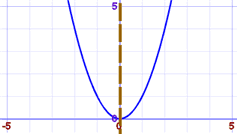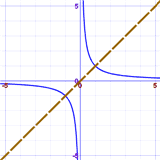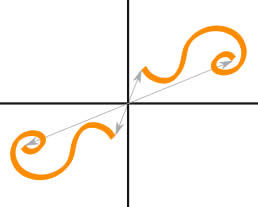Symmetrical About The Y Axis
Symmetry in Equations
Equations can have symmetry:

Graph of xtwo
Symmetry about y-axis

Graph of ane/ten
Diagonal symmetry
In other words, in that location is a mirror-prototype.
Benefits
The benefits of finding symmetry in an equation are:
- we understand the equation better
- it is easier to plot
- it can be easier to solve. When nosotros find a solution on 1 side, nosotros can then say "likewise, by symmetry, the (mirrored value)"
How to Check For Symmetry
We can often see symmetry visually, but to be really sure we should check a elementary fact:
Is the equation unchanged when using symmetric values?
How we exercise this depends on the blazon of symmetry:
For Symmetry Virtually Y-Axis
For symmetry with respect to the Y-Axis, check to see if the equation is the same when we replace x with −x:
For Symmetry About Ten-Centrality
Use the same thought as for the Y-Axis, but endeavour replacing y with −y.
Instance: is y = x3 symmetric well-nigh the ten-centrality?
Endeavor to replace y with −y:
−y = xiii
At present try to become the original equation:
Try multiplying both sides by −ane:
y = −xthree
Information technology is dissimilar.
Then y = x3 is not symmetric most the y-axis
Diagonal Symmetry
Endeavour swapping y and x (i.e. replace both y with 10 and x with y).
Instance: does y = 1/ten have Diagonal Symmetry?
Start with:
y = 1/x
Endeavour swapping y with ten:
ten = one/y
Now rearrange that: multiply both sides by y:
xy = ane
And then divide both sides by 10:
y = one/x
And we have the original equation. They are the same.
So y = ane/ten has Diagonal Symmetry
Origin Symmetry

Origin Symmetry is when every part has a matching part:
- the same altitude from the primal signal
- but in the contrary direction.
Cheque to come across if the equation is the same when we replace both 10 with −x and y with −y.
Example: does y = 1/ten have Origin Symmetry?
Showtime with:
y = 1/x
Replace x with −x and y with −y:
(−y) = 1/(−x)
Multiply both sides by −ane:
y = 1/x
And we have the original equation.
So y = i/x has Origin Symmetry
Amazing! y = 1/ten has origin symmetry likewise as diagonal symmetry!
1154, 1155, 2463, 2464, 2465, 4042, 4043, 4044, 4045, 4046
Symmetrical About The Y Axis,
Source: https://www.mathsisfun.com/algebra/equation-symmetry.html
Posted by: edwardsmajected1995.blogspot.com


0 Response to "Symmetrical About The Y Axis"
Post a Comment